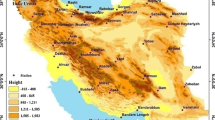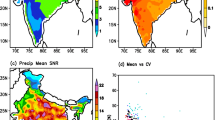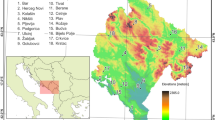Abstract
To clarify aridity/humidity status of land surface is helpful for studying environmental background and regional differences, seeking causes of environmental change, and providing a scientific basis for researches on climate change in the future. In this paper, the authors calculated potential evapotranspiration of China using data from 616 meteorological stations during the period of 1971-2000 with the Penman-Monteith model recommanded by FAO in 1998. Vysothkii’s model was used to calculate aridity/humidity index. Then the calculated results of sta-tions were interpolated to land surface using ArcGIS. Results show that the annual average potential evapotranspiration is 400-1500 mm in the whole country, 600-800 mm in most parts of it; and 350-1400 mm in growing season (April-Octobor), which is nearly 200 mm less than the annual average. According to the aridity/humidity indexes of 1.0, 1.5 and 4.0, the aridity/humidity status is categorized to four types, namely, humid, subhumid, semiarid and arid. A majority of stations (76%) are more humid in growing season than the annual average. Results of comprisons between the distribution map of aridity/humidity index with that of precipitation and vegetation indicate a good consistence of aridity/humidity status with natural environment. Therefore potential evapotranspiration calculated with modified FAO’s Penman-Monteith model in combination with aridity/humidity index that considers water balance can more reasonably explain the actual land surface aridity/humidity status of China.
Similar content being viewed by others
References
Ci Longjun, Yang Xiaohui, Chen Zhongxin, The potential impacts of climate change scenarios on desertification in China, Earth Science Frontiers (in Chinese), 2002, 9(4): 287–294.
Ma Zhuguo, Fu Congbin, Trend of surface humid index in the arid area of northern China, Acta Meteorologica Sinica (in Chinese), 2001, 59(6): 737–746.
Yang Jianping, Ding Yongjian, Chen Rensheng et al., Spatial changes of dry and wet climate boundary in China in the recent 50 years, Journal of Glaciology and Geocryology (in Chinese), 2002, 24(6): 731–736.
Shang Zongbo, Gao Qiong, Assessing the sensitivity of China water conditions to global climate changes, Acta Ecologica Sinica (in Chinese), 2001, 21(4): 528–537.
Carter, T. R., Hulme, M., Lal, M., Guidelines on the use of sce-nario data for climate impact and adaptation assessment, IPCC, Task Group on Scenarios for Impact Assessment, 1999, 6–19.
Chen Jianwei, Zhang Yixing, Discussion on relation between hu-midity index and aridity degree, Journal of Desert Research (in Chinese), 1996, 16(1): 79–82.
Zhang Juntao, Li Zhe, A study on demarcation indexes between subhumid and semiarid sectors in China, Progress in Geography (in Chinese), 1999, 18(3): 230–237.
Qu Xinfa, Zeng Yan, Miao Qilong et al., Estimation of annual ac-tual evapotranspiration from nonsaturated land surfaces with conventional meteorological data, Science in China, Ser. D. 2004, 47(3): 239–246
Sun Huinan, Discussion evapotranspiration capability using physical geography, Acta Geographica Sinica (in Chinese), 1984, 39(1): 44–51.
Deng Genyun, A meteorological calculation method for water evaporation, Acta Meteorologica Sinica (in Chinese), 1979, 37(3): 87–96.
Jesen, M. E., Burman, R. D., Allen, R. G., Evapotranspiration and irrigation water requirements, ASCE Manuals and Reports on En-gineering Practice No.70, New York: American Society of Civil Engineer, 1990, 80–112.
Allen, R. G., Pereira, L. S., Raes, D. et al., Crop evapotranspira-tion- guidelines for computing crop water requirements. FAO Irri-gation and drainage paper 56. Rome: Food and Agriculture Or-ganization of the United Nations, 1998, http://www. fao.org/do- fao.org/docrep/X0490E/x0490e00.htm
Huang Bingwei, An outline of the physico-geographical region-alization of China (1986), (the Institute of Geographic Sciences and Natural Resources Research, Chinese Academy of Sciences) Geographical Symposium 21 (in Chinese), Beijing: Science Press, 1989, 10–20.
China Physical Geography Compilation Commission, China Physical Geography-Climate (in Chinese), Beijing: Science Press, 1985, 152–158.
Zhu Gangkun, Yang Renzhang, The application of weather re-corders in economic construction (2): study of evapotranspiration over China, Acta Meteorologica Sinica (in Chinese), 1955, 26(1–2): 1–28.
Qian Jiliang, Lin Zhiguang, China national aridity/humidity cli-mate regionalization, Acta Geographica Sinica (in Chinese), 1965, 31(1): 1–13.
Chen Xianji, China climatic regionalization, Acta Meteorologica Sinica (in Chinese), 1982, 40(1): 35–47.
Xi Chengfan, China Natural Regionalization(in Chinese), Beijing: Science Press, 1984, 72–76.
Zhang Xinshi, Potential evapotranspiration index of plant and plant-climate classification (2).several major methods and in-troduction of PEP program, Acta Phytoecologica ET Geobotanica Sinica (in Chinese), 1989, 13(3): 197–207.
Ci Longjun, Wu Bo, Climatic type division and the potential ex-tent determination of desertification in China. Journal of Desert Research (in Chinese), 1997, 17(2): 107–111.
Huang Bingwei, Physico-geographical division in China, In: 60 Years of Achievements in Physical Geography (in Chinese), Beijing: Science Press, 1993, 113–123.
Penman, H. L., Natural evaporation from open water, bare soil and grass, Proceedings, Royal Society, Series A, 1948, 193: 454–465.
Allen, R. G. Smith, M., Perrier, A. et al., An update for the defini-tion of reference evapotranspiration, ICID Bulletin, 1994, 43(2): 1–34.
Min Qian, Two questions in application of Penman formula, Me-teorological Monthly (in Chinese), 1992, 18(11): 17–21.
Niu Zhenguo, Li Baoguo, Zhang Fengrong et al., A distributed model of reference evapotranspiration based on the DEM, Ad-vances in Water Science (in Chinese), 2002, 13(3): 303–307.
Monteith, J. L., Evaporation and temperature, Quarterly Journal of the Royal Meteorological Society, 1981, 107: 1–27.
Walter, I. A., Allen, R. G., Elliott, R. et al., ASCE’s standardized reference evapotranspiration equation, Proc. National Irrigation Symposium, ASAE, Phoenix: ASCE, 2000, 1–6.
Zuo Dakang, Wang Yixian, Chen Jiansui, Spatial distribution characteristics of solar radiation in China, Zuo Dakang’s Geo-graphical Research Papers (in Chinese), Beijing: Science Press, 1993, 168–185.
Wang Yixian, Affect of altitude to the two factors ä / (ä+ã) and ã /(ä+ã) in Penman formula, Acta Meteorologica Sinica (in Chi-nese), 1981, 39(4): 503–506.
Wang Ling, Chen Shenbin, Hou Guangliang, Revision of Penman formula by altitude to calculate potential evapotranspiration, Acta Meteorologica Sinica (in Chinese), 1988, 46(3): 381–383.
Gao Guodong, Lu Yurong, Li Huaijin, Calculation and analysis of potential evaporation in China, Acta Geographica Sinica (in Chi-nese), 1978, 33(2): 102–107.
Wu Shaohong, Yang Qinye, Zheng Du, Comparative study on eco-geographic regional systems between China and USA, Acta Geographica Sinica, 2003, 58(5): 686–694.
Author information
Authors and Affiliations
Corresponding author
Rights and permissions
About this article
Cite this article
Wu, S., Yin, Y., Zheng, D. et al. Aridity/humidity status of land surface in China during the last three decades. Sci. China Ser. D-Earth Sci. 48, 1510–1518 (2005). https://doi.org/10.1360/04yd0009
Received:
Revised:
Issue Date:
DOI: https://doi.org/10.1360/04yd0009




